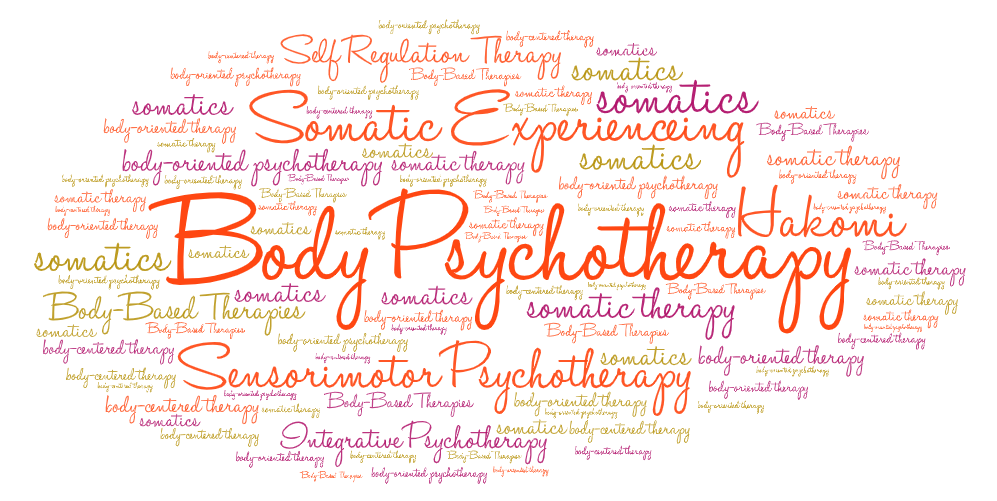Body psychotherapy is a therapeutic method that addresses resiliency and emotional self-regulation at its core.
That's because accessing body sensations, movement and imagination directly impacts the nervous system.
That's the mind body connection in action!
Transforming the way the body reacts at a fundamental level is key for increasing your capacity for conscious emotional experience
Quick Facts about body psychotherapy
- Gets beneath the "words" and in touch with a client's actual process as it's lived in the moment (providing more opportunities for real change)
- Based on the scientific notion that all emotions exist in the body as well as the mind
- Working somatically can reverse engineer emotional patterns at their root
- Attempts to work within a window that's tolerable for the client
- Possesses clear indicators to monitor when clients exceed their resiliency so the "overwhelm" can be addressed right there and then
- Based on somatic psychology and the work of Wilhelm Reich. (Many others followed.)
- Also known as body-oriented psychotherapy, body-based therapy, somatic therapy
"Body Psychotherapy" is the new kid on the block
Few would argue the impact the Beatles, Hendrix, Bob Marley, Queen (and several others) had on a generation of music lovers.
They took elements of the music world that were vital but combined together became explosive.
Organically, all together something brand new emerged. They shifted the music scene to a level that had never been seen.
That's what body psychotherapy is to the field of psychotherapy.
It's like taking pieces of what we know and pulling them together to generate a paradigm shift in thinking about therapy.
If you really want to live a BIG life and you're wondering what your first step is, consider body psychotherapy—as a client or a therapist.
Body-oriented therapy expands your life
It's a total body experience. Many folks enter therapy because they have problems managing intense emotions such as anger, fear, and anxiety.
Others may be struggling with feeling or identifying more vulnerable feelings such as toxic shame or even love.
Most of us try to overcome these emotional states by talking them away or using distractions (i.e. busy-work, alcohol, watching TV). We can push something away, but generally, it comes back on us.
In fact, we often delude ourselves into thinking that we've "worked through" an issue when it temporarily disappears.
Yet, the body is an enormous resource. Involving the body into the process of transformation creates change that's lasting and embodied.
There's no constant vigilance or effort to maintain a behaviour or thought, you feel different because you are different.

When body psychotherapy is right for you
Our bodies are not just for carrying our heads around.
When you're uptight, you feel tightness in your chest.
When you're happy, you feel light—in your body.
And when you're sad, you feel heavy—in your body.
Our body impacts our thinking and our thinking reflects our body. It's a "chicken & egg", two-way dance.
However—and this is the key important variable—these "two-way" paths are NOT equal.
The neuropathways arising from your body are 4 times the number of the pathways going from your mind to your body.
Yes, it means your body physiological state is having a stronger impact on your mind, than your mind is having on your body. (Read more here: What is BodyMindfulness?)
We're all familiar with telling our friends about a terrible event. Talking about it makes us agitated, it gets us upset. We feel it in our body. The story triggers the body.
And, typically, we know we're stressed, excited, or emotional because we "think" it. However, the way the brain is wired, it is usually only when body sensations alert us, that the mind gets engaged.
In other words, our emotions and sensations appear first in the body, and only then are noticed by the conscious mind.
Being conscious of emotions, however, doesn't mean that you can control them simply by changing your mind. Still less can the mind alone "reprogram" long-standing, nonconscious emotional reactions.
This is where body psychotherapy shines. The approach uses the physical sensations underlying emotional processes as signals to guide therapy.
It resolves emotional problems holistically by working directly and interactively with the nervous system as an equal partner.
In this way, it effectively addresses problems that are not resolvable by the conscious mind (i.e. "talk therapy") alone.
How does Body-Based Therapy work?
Body psychotherapy exploits the transforming potential of both the left 'thinking' brain and the emotion and sensation-based right brain.
It augments and enriches the talk-therapy approach, rather than replaces it.

Clients that are too charged up inside find meditation too difficult. They're ideal candidates for body psychotherapy. As the nervous system heals, they'll naturally have more control over their thoughts.
Tools used in body psychotherapy are useful to use BEFORE meditation.
At that point, it becomes easier to get under one's thoughts.
What a body psychotherapy session might look like
You and your therapist are discussing a problem you're having. She asks how you're feeling about it, and she wonders how those emotions might show up in your body.
She then invites you to pay attention to any body sensations, images or emotions that appear in that very moment. Then you follow her guidance on shifting those sensations.
With practice you ultimately become aware of how you experience emotions in your body, and in turn, how they affect your thoughts.
More importantly, with repeated attention your nervous system will "learn" to quiet down and regulate itself, even in the face of stress and change in your life.
Body psychotherapy works because the brain is
"experience-dependent"
In order to change habitual emotional patterns you need to listen to and respect what the body is telling you.
These patterns were laid down in the nervous system and record our earliest experiences of the world.
It is only through new experiences that old patterns can be modified or replaced.
Body psychotherapy exploits this biological fact by working interactively and directly with the nervous system.
The idea is to recreate as much as possible the initial conditions in which the emotional patterns were formed so long ago.
To accomplish this, the therapist and client must first establish a safe and secure relationship, as the physical and emotional sensations that arise in therapy can often feel overwhelming.
Where body psychotherapy departs from other therapies is that there's a more accurate measure of their safety other than the client merely stating "oh, I'm fine".
The body doesn't lie. If indeed the client was feeling "safe" there'd be no tension in their body. They'd feel warm.
With body based techniques the client readily learns to trust their own body signals.
They begin to discover that it is only after the uncomfortable or distressing sensations that arise have been experienced and digested that the verbal, analytical powers of the left brain are made effective.
Strictly speaking, body psychotherapy is not an alternative to conventional "talk therapies". By making the physical manifestations of underlying emotional patterns the core of its approach, it amounts to a new paradigm of psychotherapy.
What "talk therapies" miss out on
Traditional "talk therapies" (especially Cognitive Behavioral Therapy - CBT) attempt to change your emotions or behavior by changing your thoughts and addressing irrational beliefs (i.e. through the left brain).**
Body psychotherapy works in the reverse, by using the body and your emotions to change how your nervous system responds. That is, it works through the right brain, not the left.
You see, although thoughts can marginally change our emotions, it is far more efficient - in terms of the way the brain is designed to work "from the bottom up".
Body psychotherapy enables the brain to update its emotional wiring naturally (i.e. using the right brain), rather than willfully trying to impose change "from the top down" using thoughts (i.e. through the left brain).
If you think of the times you've tried to make yourself feel (or not feel) a certain way, you'll see that using a left-brain strategy to change a right-brain-based emotion is a prescription for futility.
**(Newer "emotion-based" therapies are a step in the right direction as they allow for the natural ebb and flow of the nervous system. The caution is that when applied, there's no precise measure on whether the client's activation is "contained" or not. Signals from the body confirm whether the client is going outside a window that's tolerable for them.)
Mind Body Psychotherapy
Body psychotherapy is one of several types of mind-body psychotherapies.
Mind-body psychotherapies have been around for years, but it's only since neuroscience started revealing basic principles in the labs that they started to take hold.

Today, brain scans (e.g. PET, CAT & SPECT) and high tech neurofeedback devices are showing us the dynamic interplay between our thoughts and feelings, how feelings are "stored" in the body, and how they affect our thought processes.
Applying these discoveries in a clinical setting has been a HUGE for psychotherapy practice.
Mind-body psychotherapy is based on the notion that the energies associated with physical and emotional stress are "stored" in various body tissues; stress is stored in the muscles, for example.
Balance in the nervous system is restored only after these energies are discharged. Once this happens, the client is much more resilient in the face of life changes and emotional stress.
Mind-body psychotherapy is designed to optimize how the right brain works and that automatically translates to better emotional self-regulation. We believe it does this by "rewiring" areas that are impervious to left-brain directed therapies**.
As an example, the body-based symptoms of anxiety and depression are believed to be largely under the influence of the right-brain processes. This makes mind-body psychotherapy an effective solution for these types of conditions.
Because the right-brain works continually behind the scenes (i.e. non-consciously) to regulate our moods and behaviours, it ultimately determines the quality of life.
For the most part, traditional forms of counseling underestimate the transformative power of the right-brain. This is the reason why mind-body therapy, with its focus on right-brain processes, can offer holistic, quality of life improvements that are unattainable by traditional psychotherapy.
**How often have you witnessed a client re-hashing a story and failing to get to the main emotional drivers of their feelings and behaviours? Body psychotherapy techniques offer a gentle way for clients to access these emotions directly.
Mind-Body psychotherapy improves your health
An added benefit of mind-body psychotherapy is that it reinvigorates the autoimmune system. This may provide hope to such stubborn ailments as rampant allergies, arthritis, asthma and relatedly, conditions such as digestive disorders, insomnia, PMS and menopause symptoms, hormonal imbalances, chronic headaches, cardiovascular disorders and high or low blood pressure.
It should be no surprise, then, that yoga has become so popular. Those who do yoga regularly have discovered its secret (even if they don't know they know, if you know what I mean):
As you calm the body you automatically and naturally calm your mind.
A calmer mind means clearer thoughts.
This effect illustrates the holistic nature of mind-body therapy, where the body itself serves as the basis for healing both mind and soul.
Reviewed by: Vancouver Counselling with Janice Stuart Ph.D. and Erika Moore RMT
Related Topics
Mind Body Connection and your Health
Body work therapy
External Link
Sensorimotor Psychotherapy
References
Levine, Peter, A. (1997). Waking the Tiger: Healing Trauma. Berkeley, California: North Atlantic Books.
Check out Dr. Levine's site where you can find a body-based therapist: TraumaHealing.org
Price, Cynthia J., Weng, Y. Helen "Facilitating Adaptive Emotion Processing and Somatic Reappraisal via Sustained Mindful Interoceptive Attention" in Front. Psychol., 08 September 2021 Sec. Psychology for Clinical Settings, Volume 12 - 2021
Scaer, Robert C., "Precarious Present" in Psychotherapy Networker, Nov/Dec 2006.
Scaer, Robert, C., (2005). The Trauma Spectrum, New York: W. W. Norton & Company.

